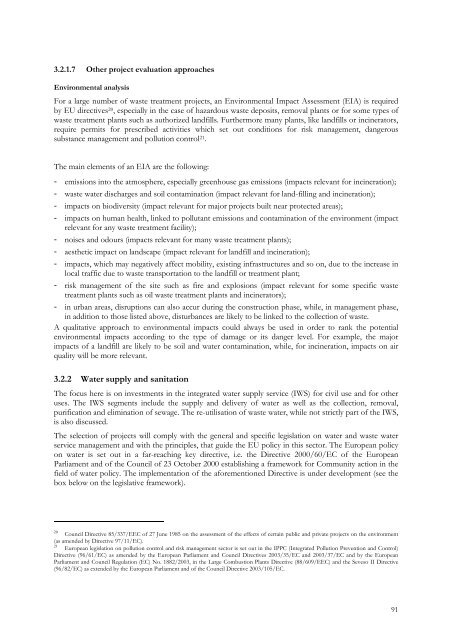Guide to COST-BENEFIT ANALYSIS of investment projects - Ramiri
Guide to COST-BENEFIT ANALYSIS of investment projects - Ramiri
Guide to COST-BENEFIT ANALYSIS of investment projects - Ramiri
Create successful ePaper yourself
Turn your PDF publications into a flip-book with our unique Google optimized e-Paper software.
3.2.1.7 Other project evaluation approachesEnvironmental analysisFor a large number <strong>of</strong> waste treatment <strong>projects</strong>, an Environmental Impact Assessment (EIA) is requiredby EU directives 20 , especially in the case <strong>of</strong> hazardous waste deposits, removal plants or for some types <strong>of</strong>waste treatment plants such as authorized landfills. Furthermore many plants, like landfills or incinera<strong>to</strong>rs,require permits for prescribed activities which set out conditions for risk management, dangeroussubstance management and pollution control 21 .The main elements <strong>of</strong> an EIA are the following:- emissions in<strong>to</strong> the atmosphere, especially greenhouse gas emissions (impacts relevant for incineration);- waste water discharges and soil contamination (impact relevant for land-filling and incineration);- impacts on biodiversity (impact relevant for major <strong>projects</strong> built near protected areas);- impacts on human health, linked <strong>to</strong> pollutant emissions and contamination <strong>of</strong> the environment (impactrelevant for any waste treatment facility);- noises and odours (impacts relevant for many waste treatment plants);- aesthetic impact on landscape (impact relevant for landfill and incineration);- impacts, which may negatively affect mobility, existing infrastructures and so on, due <strong>to</strong> the increase inlocal traffic due <strong>to</strong> waste transportation <strong>to</strong> the landfill or treatment plant;- risk management <strong>of</strong> the site such as fire and explosions (impact relevant for some specific wastetreatment plants such as oil waste treatment plants and incinera<strong>to</strong>rs);- in urban areas, disruptions can also accur during the construction phase, while, in management phase,in addition <strong>to</strong> those listed above, disturbances are likely <strong>to</strong> be linked <strong>to</strong> the collection <strong>of</strong> waste.A qualitative approach <strong>to</strong> environmental impacts could always be used in order <strong>to</strong> rank the potentialenvironmental impacts according <strong>to</strong> the type <strong>of</strong> damage or its danger level. For example, the majorimpacts <strong>of</strong> a landfill are likely <strong>to</strong> be soil and water contamination, while, for incineration, impacts on airquality will be more relevant.3.2.2 Water supply and sanitationThe focus here is on <strong>investment</strong>s in the integrated water supply service (IWS) for civil use and for otheruses. The IWS segments include the supply and delivery <strong>of</strong> water as well as the collection, removal,purification and elimination <strong>of</strong> sewage. The re-utilisation <strong>of</strong> waste water, while not strictly part <strong>of</strong> the IWS,is also discussed.The selection <strong>of</strong> <strong>projects</strong> will comply with the general and specific legislation on water and waste waterservice management and with the principles, that guide the EU policy in this sec<strong>to</strong>r. The European policyon water is set out in a far-reaching key directive, i.e. the Directive 2000/60/EC <strong>of</strong> the EuropeanParliament and <strong>of</strong> the Council <strong>of</strong> 23 Oc<strong>to</strong>ber 2000 establishing a framework for Community action in thefield <strong>of</strong> water policy. The implementation <strong>of</strong> the aforementioned Directive is under development (see thebox below on the legislative framework).20Council Directive 85/337/EEC <strong>of</strong> 27 June 1985 on the assessment <strong>of</strong> the effects <strong>of</strong> certain public and private <strong>projects</strong> on the environment(as amended by Directive 97/11/EC).21European legislation on pollution control and risk management sec<strong>to</strong>r is set out in the IPPC (Integrated Pollution Prevention and Control)Directive (96/61/EC) as amended by the European Parliament and Council Directives 2003/35/EC and 2003/37/EC and by the EuropeanParliament and Council Regulation (EC) No. 1882/2003, in the Large Combustion Plants Directive (88/609/EEC) and the Seveso II Directive(96/82/EC) as extended by the European Parliament and <strong>of</strong> the Council Directive 2003/105/EC.91




